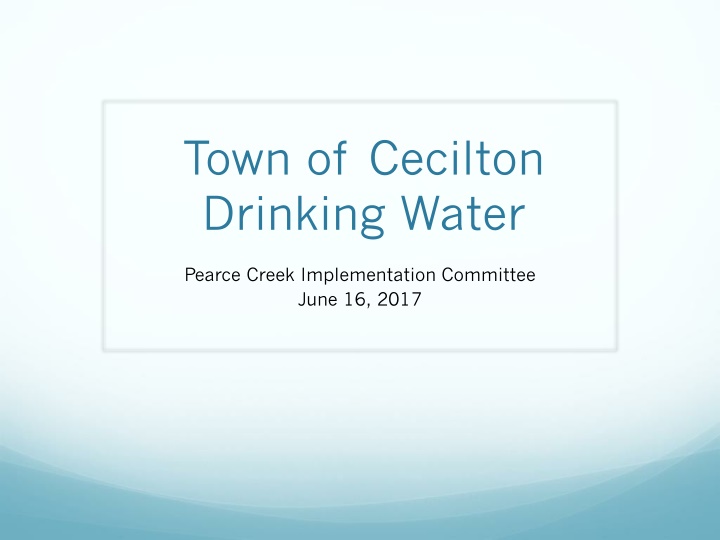
Ensuring Safe Drinking Water Quality in Cecilton
The town of Cecilton sources its drinking water from a confined aquifer, treated before distribution, following EPA regulations to meet quality standards. Regulations like the Safe Drinking Water Act (SDWA) and oversight by the Maryland Department of the Environment ensure compliance and safety. Consumer Confidence Reports provide transparency to the public through annual water quality reports.
Download Presentation

Please find below an Image/Link to download the presentation.
The content on the website is provided AS IS for your information and personal use only. It may not be sold, licensed, or shared on other websites without obtaining consent from the author. If you encounter any issues during the download, it is possible that the publisher has removed the file from their server.
You are allowed to download the files provided on this website for personal or commercial use, subject to the condition that they are used lawfully. All files are the property of their respective owners.
The content on the website is provided AS IS for your information and personal use only. It may not be sold, licensed, or shared on other websites without obtaining consent from the author.
E N D
Presentation Transcript
Town of Cecilton Drinking Water Pearce Creek Implementation Committee June 16, 2017
Overview The Town water is sourced from a confined aquifer (Magothy Formation) that lies about 100 feet below land surface. Once the water is pumped from the aquifer, it is then treated before it enters the Town s water distribution system.
Drinking Water Regulations The Safe Drinking Water Act (SDWA) is the primary federal law that ensures the quality of national drinking water. The SWDA is overseen by the US Environmental Protection Agency (EPA). SWDA After review of the health effects data, the EPA sets a Maximum Contaminant Level Goal (MCLG). The MCLG is the maximum level of a contaminant in drinking water at which no known or anticipated adverse effect on the health of persons would occur, while allowing for an adequate margin of safety. MCLG The MCLG is used to determine the Maximum Contamination Level (MCL). The MCL is the maximum level allowed of a contaminant in water that is delivered to any user of a public water system. MCL
Drinking Water Regulations EPA Primary Drinking Water Regulations provide legally enforceable standards and treatment techniques that apply to public water systems. Primary Drinking Water Standards (primarily MCLs) apply to: Microorganisms Disinfectants Disinfection Byproduct Inorganic Chemicals (includes nutrients and metals) Organic Chemicals (i.e. pesticides and fuel additives) Radionuclides EPA Secondary Drinking Water Regulations provide non- enforceable guidelines regulating contaminants that may cause cosmetic effects (such as skin or tooth discoloration) or aesthetic effects (such as taste, odor, or color).
Drinking Water Regulations The Maryland Department of the Environment (MDE) follows the EPA National Drinking Water Regulations. The mission is accomplished through proper planning for water withdrawal, protection of water sources that are used for public water supplies, oversight and enforcement of routine water quality monitoring at public water systems, regular onsite inspections of water systems, and prompt response to water supply emergencies. MDE s mission is to ensure safe and sustainable supplies of water for drinking and other purposes to meet current and future needs of communities and ecosystems. The Town of The Town of Cecilton s Federal Federal and State requirements and State requirements. Cecilton s drinking water meets drinking water meets
Consumer Confidence Reports The Town of Cecilton is required by law to issue a Water Quality Report, known as a Consumer Confidence Report (CCR), to the public every year. The report lists constituents that were detected (at any level) in the samples throughout the year, the reason the constituent is present, and any violations. List of constituents tested and testing frequency: Coliform - Minimum 5 samples per month Turbidity Once per day Inorganic Chemicals (includes metals and nutrients) Annually Volatile Organic Chemicals (VOCs) Annually Synthetic Organic Chemicals (SOCs) 2 quarterly samples per year Gross Alpha Particle Activity, Radium-226, Radium-228, Uranium Once every 9 years Please note that a Please note that a detection does not mean an detection does not mean an exceedance exceedance.
Consumer Confidence Reports Recent Town of Cecilton CCR findings (2014 - 2016): While there were some detections, there were NO exceedances exceedances. Most of the detections were caused by: Byproducts of the disinfection process Byproducts of chlorination Natural occurrences from surrounding geological formations NO If you have any questions, please contact: The Town of Cecilton, MD P .O. Box 317 Cecilton, Maryland 21913 Phone: (410)-275-2692
Resources For more information: Federal: https://www.epa.gov/sdwa https://www.epa.gov/dwregdev/drinking-water- regulations-and-contaminants https://www.epa.gov/environmental-topics/water- topics#what-you-can-do https://www.epa.gov/dwregdev/how-epa-regulates- drinking-water-contaminants State: http://mde.maryland.gov/programs/water/water_supply /Pages/index.aspx http://www.dsd.state.md.us/comar/SubtitleSearch.aspx ?search=26.04.01.%2a
